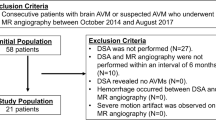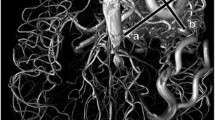Abstract
Objectives
To evaluate the usefulness of 4D-MR angiography based on super-selective pseudo-continuous ASL combined with keyhole and view-sharing (4D-S-PACK) for vessel-selective visualization and to examine the ability of this technique to visualize brain arteriovenous malformations (AVMs).
Methods
In this retrospective study, 15 patients (ten men and five women, mean age 44.0 ± 16.9 years) with brain AVMs were enrolled. All patients were imaged with 4D-PACK (non-selective), 4D-S-PACK, and digital subtraction angiography (DSA). Observers evaluated vessel selectivity, identification of feeding arteries and venous drainage patterns, visualization scores, and contrast-to-noise ratio (CNR) for each AVM component. Measurements were compared between the MR methods.
Results
Vessel selectivity was graded 4 in 43/45 (95.6%, observer 1) and 42/45 (93.3%, observer 2) territories and graded 3 in two (observer 1) and three (observer 2) territories. The sensitivity and specificity for identification of feeding arteries for both observers was 88.9% and 100% on 4D-PACK, and 100% and 100% on 4D-S-PACK, respectively. For venous drainage, the sensitivity and specificity was 100% on both methods for observer 1. The sensitivity and specificity for observer 2 was 94.4% and 83.3% on 4D-PACK, and 94.4% and 91.7% on 4D-S-PACK, respectively. The CNRs at the timepoint of 1600 ms were slightly lower in 4D-S-PACK than in 4D-PACK for all AVM components (Feeding artery, p = .02; nidus, p = .001; and draining artery, p = .02). The visualization scores for both observers were not significantly different between 4D-PACK and 4D-S-PACK for all components.
Conclusions
4D-S-PACK could be a useful non-invasive clinical tool for assessing hemodynamics in brain AVMs.
Key Points
• The 4D-MR angiography based on super-selective pseudo-continuous arterial spin labeling combined with CENTRA-keyhole and view-sharing (4D-S-PACK) enabled excellent vessel selectivity.
• The 4D-S-PACK enabled the perfect identification of feeding arteries of brain arteriovenous malformation (AVM).
• 4D-S-PACK could be a non-invasive clinical tool for assessing hemodynamics in brain AVMs.





Similar content being viewed by others
Abbreviations
- 4D-PACK:
-
4D-MR angiography based on pseudo-continuous arterial spin labeling combined with CENTRA-keyhole and view-sharing
- 4D-S-PACK:
-
4D-MR angiography based on super-selective pCASL with CENTRA-keyhole and view-sharing
- AVM:
-
Arteriovenous malformation
- CINEMA:
-
Contrast-inherent inflow-enhanced multi-phase angiography
- CNR:
-
Contrast-to-noise ratio
- DSA:
-
Digital subtraction angiography
- ECA:
-
External carotid artery
- ICA:
-
Internal carotid artery
- MIP:
-
Maximum intensity projection
- pCASL:
-
Pseudo-continuous arterial spin labeling
References
Hernesniemi JA, Dashti R, Juvela S, Vaart K, Niemela M, Laakso A (2008) Natural history of brain arteriovenous malformations: a long-term follow-up study of risk of hemorrhage in 238 patients. Neurosurgery 63:823–829 discussion 829-831
Laakso A, Dashti R, Juvela S, Isarakul P, Niemela M, Hernesniemi J (2011) Risk of hemorrhage in patients with untreated Spetzler-Martin grade IV and V arteriovenous malformations: a long-term follow-up study in 63 patients. Neurosurgery 68:372–377 discussion 378
Murthy SB, Merkler AE, Omran SS et al (2017) Outcomes after intracerebral hemorrhage from arteriovenous malformations. Neurology 88:1882–1888
ApSimon HT, Reef H, Phadke RV, Popovic EA (2002) A population-based study of brain arteriovenous malformation: long-term treatment outcomes. Stroke 33:2794–2800
Brown RD Jr, Wiebers DO, Forbes G et al (1988) The natural history of unruptured intracranial arteriovenous malformations. J Neurosurg 68:352–357
Halim AX, Johnston SC, Singh V et al (2004) Longitudinal risk of intracranial hemorrhage in patients with arteriovenous malformation of the brain within a defined population. Stroke 35:1697–1702
Griffiths PD, Hoggard N, Warren DJ, Wilkinson ID, Anderson B, Romanowski CA (2000) Brain arteriovenous malformations: assessment with dynamic MR digital subtraction angiography. AJNR Am J Neuroradiol 21:1892–1899
Falk Delgado A, Van Westen D, Nilsson M et al (2019) Diagnostic value of alternative techniques to gadolinium-based contrast agents in MR neuroimaging-a comprehensive overview. Insights Imaging 10:84
Uchino H, Ito M, Fujima N et al (2015) A novel application of four-dimensional magnetic resonance angiography using an arterial spin labeling technique for noninvasive diagnosis of Moyamoya disease. Clin Neurol Neurosurg 137:105–111
Iryo Y, Hirai T, Kai Y et al (2014) Intracranial dural arteriovenous fistulas: evaluation with 3-T four-dimensional MR angiography using arterial spin labeling. Radiology 271:193–199
Iryo Y, Hirai T, Nakamura M et al (2015) Collateral circulation via the circle of Willis in patients with carotid artery steno-occlusive disease: evaluation on 3-T 4D MRA using arterial spin labelling. Clin Radiol 70:960–965
Iryo Y, Hirai T, Nakamura M et al (2016) Evaluation of intracranial arteriovenous malformations with four-dimensional arterial-spin labeling-based 3-T magnetic resonance angiography. J Comput Assist Tomogr 40:290–296
Togao O, Hiwatashi A, Obara M et al (2018) Acceleration-selective arterial spin-labeling MR angiography used to visualize distal cerebral arteries and collateral vessels in Moyamoya disease. Radiology 286:611–621
Togao O, Hiwatashi A, Obara M et al (2018) 4D ASL-based MR angiography for visualization of distal arteries and leptomeningeal collateral vessels in moyamoya disease: a comparison of techniques. Eur Radiol 28:4871–4881
Togao O, Hiwatashi A, Yamashita K et al (2019) Acceleration-selective arterial spin labeling MR angiography for visualization of brain arteriovenous malformations. Neuroradiology 61:979–989
Obara M, Togao O, Beck GM et al (2018) Non- non-cofvced 4D intracranial MR angiography based on pseudo-continuous arterial spin labeling with the keyhole and view-sharing technique. Magn Reson Med 80:719–725
Suzuki Y, Fujima N, van Osch MJP (2019) Intracranial 3D and 4D MR angiography using arterial spin labeling: technical considerations. Magn Reson Med Sci. https://doi.org/10.2463/mrms.rev.2019-0096
Lindner T, Jensen-Kondering U, van Osch MJ, Jansen O, Helle M (2015) 3D time-resolved vessel-selective angiography based on pseudo-continuous arterial spin labeling. Magn Reson Imaging 33:840–846
Fujima N, Osanai T, Shimizu Y et al (2016) Utility of noncontrast-enhanced time-resolved four-dimensional MR angiography with a vessel-selective technique for intracranial arteriovenous malformations. J Magn Reson Imaging 44:834–845
Okell TW, Schmitt P, Bi X et al (2016) Optimization of 4D vessel-selective arterial spin labeling angiography using balanced steady-state free precession and vessel-encoding. NMR Biomed 29:776–786
Suzuki Y, Okell TW, Fujima N, van Osch MJP (2019) Acceleration of vessel-selective dynamic MR angiography by pseudocontinuous arterial spin labeling in combination with acquisition of ConTRol and labEled images in the same shot (ACTRESS). Magn Reson Med 81:2995–3006
Helle M, Norris DG, Rufer S, Alfke K, Jansen O, van Osch MJ (2010) Superselective pseudocontinuous arterial spin labeling. Magn Reson Med 64:777–786
Lindner T, Austein F, Jansen O, Helle M (2018) Self-controlled super-selective arterial spin labelling. Eur Radiol 28:1227–1233
Jensen-Kondering U, Lindner T, van Osch MJ, Rohr A, Jansen O, Helle M (2015) Superselective pseudo-continuous arterial spin labeling angiography. Eur J Radiol 84:1758–1767
Obara M, Togao O, Helle M et al (2018) Investigation of intracranial artery selective visualization in superselective 4D-MR angiography with pseudo-continuous arterial spin labeling combined with CENTRA-keyhole and view-sharing (SS-4D-PACK). Proc Int Soc Magn Reson Med 27:185
Cicchetti DV, Sparrow SA (1981) Developing criteria for establishing interrater reliability of specific items: applications to assessment of adaptive behavior. Am J Ment Defic 86:127–137
Xu J, Shi D, Chen C et al (2011) Noncontrast-enhanced four-dimensional MR angiography for the evaluation of cerebral arteriovenous malformation: a preliminary trial. J Magn Reson Imaging 34:1199–1205
Yu S, Yan L, Yao Y et al (2012) Noncontrast dynamic MRA in intracranial arteriovenous malformation (AVM), comparison with time of flight (TOF) and digital subtraction angiography (DSA). Magn Reson Imaging 30:869–877
Raoult H, Bannier E, Robert B, Barillot C, Schmitt P, Gauvrit JY (2014) Time-resolved spin-labeled MR angiography for the depiction of cerebral arteriovenous malformations: a comparison of techniques. Radiology 271:524–533
Helle M, Wenzel F, van de Ven K, Boernert P (2018) Advanced automatic planning for super-selective arterial spin labeling flow territory mapping. Proc Int Soc Magn Reson Med 26:302
Acknowledgements
This work was supported by JSPS KAKENHI Grant Number JP17K10410 and JP20K08111.
Funding
This work was supported by JSPS KAKENHI Grant Number JP17K10410 and JP20K08111.
Author information
Authors and Affiliations
Corresponding author
Ethics declarations
Guarantor
The scientific guarantor of this publication is Akio Hiwatashi.
Conflict of interest
Two authors (M.O., M.V.C.) were employees of Philips Healthcare and provided technical support for sequence development but were not involved in the study design or interpretation of the data. The institutional authors, who were not employees of Philips Healthcare, were in control of all the data.
Statistics and biometry
No complex statistical methods were necessary for this paper.
Informed consent
Written informed consent was waived by the Institutional Review Board.
Ethical approval
Institutional review board approval was obtained
Methodology
• retrospective
• diagnostic study
• performed at one institution
Additional information
Publisher’s note
Springer Nature remains neutral with regard to jurisdictional claims in published maps and institutional affiliations.
Electronic supplementary material
Supplementary Material 1
(Movies). A 60-year-old woman with brain AVM. Left internal carotid arteriograms (A. lateral view) shows that the AVM is supplied by multiple branches from the left middle cerebral artery. Vertebral arteriograms (AVI 526 kb)
330_2020_7057_MOESM2_ESM.avi
B. lateral view) show that this AVM is also supplied by the left posterior cerebral artery. The 4D-MR angiography based on super-selective pseudo-continuous arterial spin labeling combined with CENTRA-keyhole and view-sharing (4D-S-PACK) labelling the left internal carotid artery (AVI 550 kb)
330_2020_7057_MOESM3_ESM.avi
C. sagittal view) shows the AVM is supplied by the left middle cerebral artery as seen on the digital subtraction angiography. The 4D-S-PACK labelling the bilateral vertebral arteries (AVI 54 kb)
330_2020_7057_MOESM4_ESM.avi
D. sagittal view) shows the AVM is also supplied by the left posterior cerebral artery as seen on the digital subtraction angiography. On the nonselective 4D-MR angiography based on pseudo-continuous arterial spin labeling combined with CENTRA-keyhole and view-sharing (4D-PACK (AVI 48 kb)
330_2020_7057_MOESM5_ESM.avi
E. multiple arteries overlapped in the maximum intensity projection image, making it difficult to identify the feeding arteries. (AVI 83 kb)
Supplementary Material 2
(Movies). A 47-year-old woman with brain AVM. Left internal carotid arteriograms (A. anterior-posterior view (AVI 741 kb)
330_2020_7057_MOESM7_ESM.avi
B. lateral view) show that the AVM in the left cerebrum is supplied by the left middle cerebral artery. Contrast-enhanced 4D-CT angiography (AVI 649 kb)
330_2020_7057_MOESM9_ESM.avi
D. sagittal view) clearly depicts all compartments of the AVM; however temporal resolution (1 sec) is limited, and it is difficult to distinguish feeding arteries because of the lack of vessel selectivity. The 4D-MR angiography based on super-selective pseudo-continuous arterial spin labeling combined with CENTRA-keyhole and view-sharing (4D-S-PACK) labelling the left internal carotid artery (AVI 195 kb)
330_2020_7057_MOESM12_ESM.avi
G. axial view) shows the AVM is supplied by the left middle cerebral artery as seen on the digital subtraction angiography. (AVI 107 kb)
Rights and permissions
About this article
Cite this article
Togao, O., Obara, M., Helle, M. et al. Vessel-selective 4D-MR angiography using super-selective pseudo-continuous arterial spin labeling may be a useful tool for assessing brain AVM hemodynamics. Eur Radiol 30, 6452–6463 (2020). https://doi.org/10.1007/s00330-020-07057-4
Received:
Revised:
Accepted:
Published:
Issue Date:
DOI: https://doi.org/10.1007/s00330-020-07057-4




